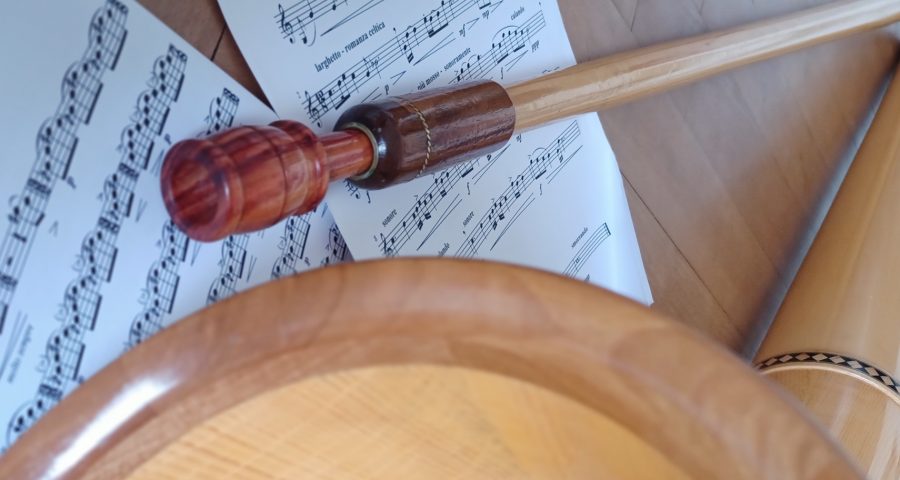Preliminary remarks on lessons 1 & 2: In this part of the course you will play your first sounds and simple sequences by ear. You will also get an insights into the histor of the alphorn and international alphorn community. Set aside a week or two for these two lessons.
In this lesson you will get to know your instrument and blow the first sounds.
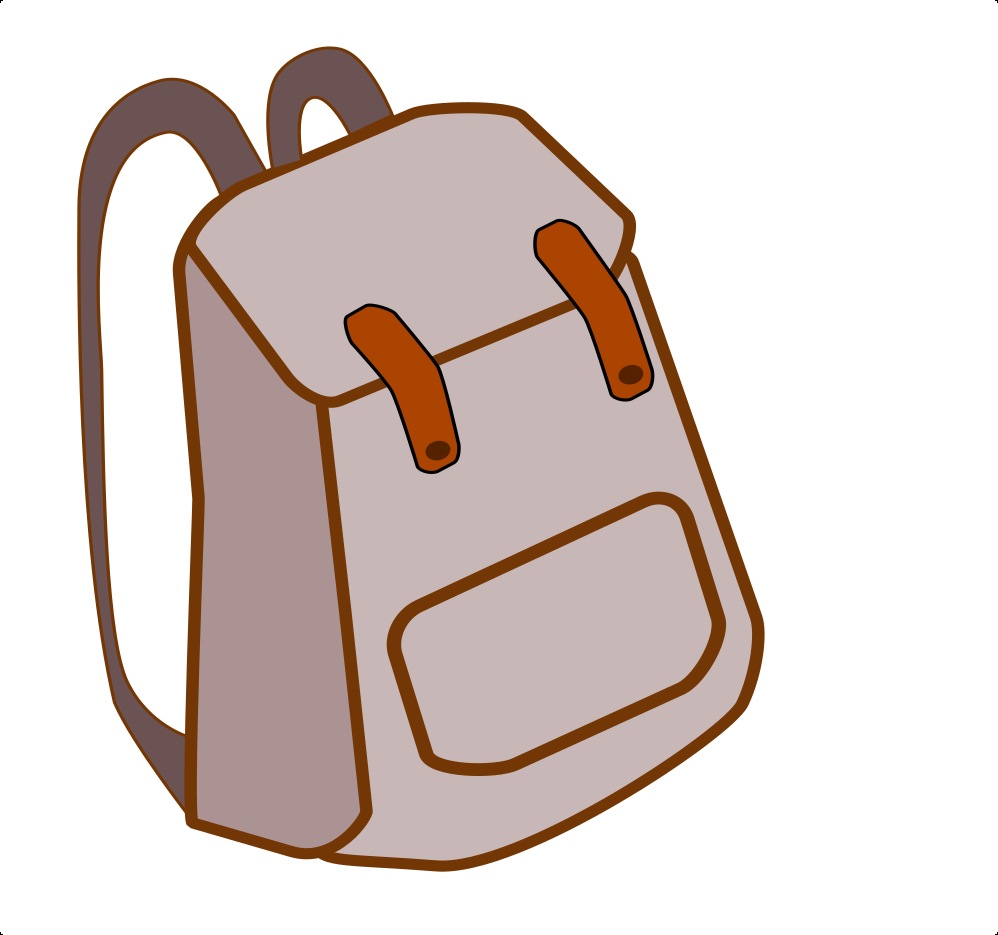 The Alphorn
The Alphorn
In the well-known classification of Hornbostel-Sachs, the alphorn belongs to the family of natural trumpets. Their sound is generated by the vibration of the lips. While the pitch of chromatic trumpets can be varied in semitone steps by means of valves (trumpet), a slide mechanism (trombone) or finger holes (cornett), natural trumpets are – to put it simply – tubes with a bell at the end. The tube of the alphorn is conical, i.e. the diameter increases towards the bell, in contrast to the cylindrical tube of a valved trumpet. Due to the tone generation, the alphorn is sometimes assigned to “brass” instruments (this is what the Federal Yodelling Association does, for example) – while the saxophone belongs to the “woodwind” instruments. In fact, alphorn and (other) brass instruments have a lot in common and many of the best alphorn players have emnjoyed a classical training on the French horn, trumpet or trombone. The alphorn differs from other natural trumpets in its origin (a “shepherd’s horn” from the alpine environment), its shape and the construction material wood. However, modern carbon fiber alphorns are still considered alphorns.
Up until the end of the 19th century, alphorns were made in different lengths and shapes. The instruments on artistic representations as well as preserved historical alphorns were often significantly shorter and thinner / narrower than the alphorns that are common today.
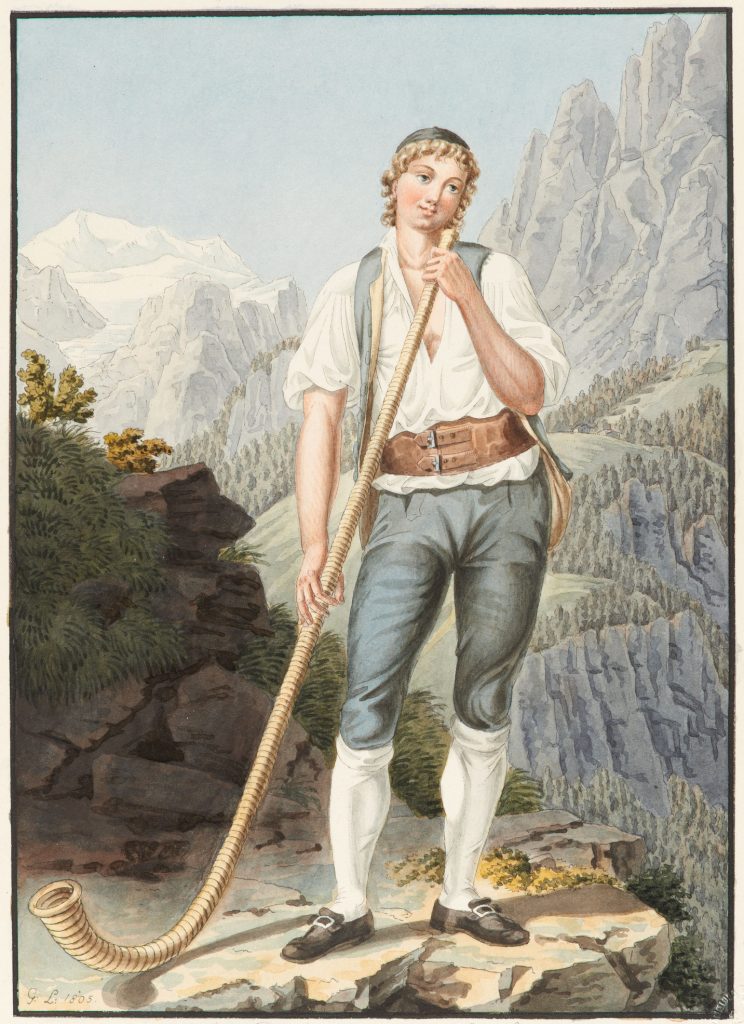
Two variants of the alphorn exist today: the well-known long alphorn (the “alphorn” in the actual sense) and the Büchel. The Büchel comes from central Switzerland (especially the Muotathal valley in the canton of Schwyz) and is not very well known even in Switzerland. With its specific shape, it is reminiscent of a trumpet. It is quite hard to play and the short pieces written for Büchel sound archaic and a bit weird to modern ears. The tuning of the Büchel is usually B flat or C, hence half an octave above the alphorn. At yodelling festivals you may hear Büchel in A flat, although many Büchel players would not consider them as real Büchel. Here is a short video with a Muotathaler Büchel-Gsätzli:
The term alphorn usually refers to the long, stretched version with the large, curved bell. Two tunings are common: the alphorn in F with a length of 368cm and the alphorn in F sharp/G flat with 347 cm. Other tunings (from E to A flat) are rare. F sharp horns are considered the standard in Switzerland. This somewhat strange choice of key is a historical accident: an alphorn builder had built a particularly good-sounding horn, which was then copied several times. Outside of Switzerland F horns are more common. Of course, this tuning is better suited for playing together with other instruments. Whether F or F sharp sounds better is a matter of taste.
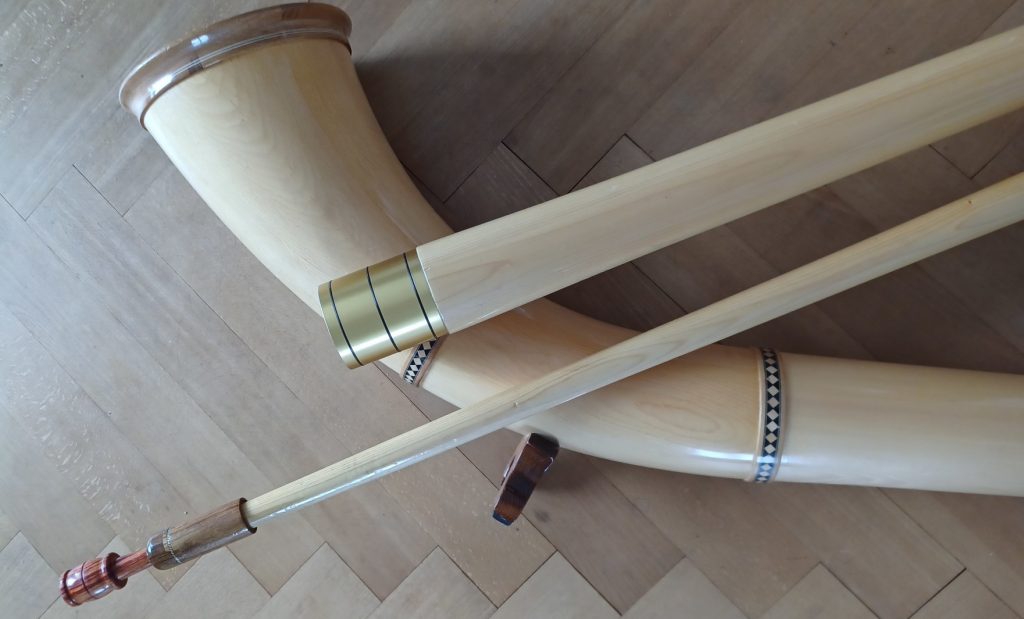
The shape of the bell differs between alphorns. Traditionally, the bells of “Bernese” horns are somewhat more voluminous and curved, while the “Central Switzerland” horns are somewhat narrower and flatter. This difference seems to have leveled out, as many alphorn makers now produce their own designs somewhere in between the two. The bell is key to the intonation of the alphorn; only thanks to its curvature is it possible to play the harmonics on the alphorn.
Most alphorns consist of three parts that snap together with aluminum or brass bushings. The “barrel” into which the mouthpiece is inserted is usually located on the top part, the “hand pipe”. This is followed by the “middle part” and finally the lower part with the bell. Some alphorn makers also offer alphorns with 4, 5, or more parts; these instruments are easier to transport but have more critical connections.
Wooden horns are mostly made from slow-growing mountain spruce. Preference is given to the rare variety of hazel spruce with its specific grain; only a few logs meet the requirements for tonewood. Some alphorn makers also swear by “moon wood” – wood cut in winter around new moon. In addition to spruce, Swiss stone pine is also common. Pine horns have a special look with intergrown branches and sound warmer (but less brilliant) than spruce. Occasionally other types of wood are used, such as Weymouth pine, walnut or cherry.
Alphorn builders hollow out two halves for each part and then glue them together. Usually a hardwood ring is added for the cup and a wrapping of pedigree cane to protect it from dents and scratches. The wrapping also increases the mass of the alphorn, changing the response and sound – unwound horns allow for more virtuosic playing, but require a greater degree of control. Sometimes the tubes are formed from glued veneer. In addition to alphorns made of wood, those made of carbon have become established – many alphorn players own one as a second instrument that is easy to transport.
![]() Further information
Further information
- Here a video that shows how an alphorn is built. In this video, the alphorn maker uses glued staves instead of halved wood trunks (a cheaper and inferior method).
- Adolf Oberli (1879-1972) was one of pioneers of alphorn building. He can be seen in this documentary from 1958.
 My alphorn
My alphorn
Heirlooms or items on loan from family or friends are ideal for getting started. If you can’t get an alphorn of acceptable quality this way, you have the following options:
- Rental instruments. Alphorn builders and larger instrument dealers sometimes offer the option of hire purchase. The rental price is usually around CHF 100 per month and is later credited when purchasing an instrument. This solution can be useful if you are unsure whether your current enthusiasm will last for longer than the first three months; However, I would be cautious about leases with a longer minimum period. Every hire purchase is like an engagment: if you later run into a more attractive alphorn, you end up in a dilemma.
- Beginner’s models. A cheap entry-level model is certainly good enough for 2-3 years and can later be sold second-hand – depending on the condition – for around 2/3 of the original price (e.g. to larger alphorn ensembles who are always looking for instruments for their newcomers are). However, later resale only works if there is a certain demand in your area. Also keep in mind that the cheapest alphorns can hardly be resold. Inexpensive entry-level models are available, for example, from Neumann or Heimatklang starting at about 1600-2000 CHF.
- Second- Hand instruments. Of course there are good second-hand instruments, but if you are not familiar with alphorns, you should not buy a second-hand instrument on your own. This applies in particular to offers on the internet. There are numerous alphorn collectors who graze through the good offers within a very short time and leave the trash to the naive beginners. If you look for second-hand instruments, get help!
- Watering can alphorn. After many years of extensive research, I can recommend an improvised alphorn made from hoses and a watering can. You need a bit more than 3m of hoses (I use approx. 1m of a climate drain hose with diameter 25mm, 2m with diameter 19mm and smaller pieces with diameter 16mm and 13mm; inserted together and stabilized with duct tape they imitate a conical form of the alphorn) and a solid watering can (I use a 10 liter model by Stöckli). For corresponding mouthpieces, see here or here. Of course, this instrument doesn’t sound nearly as good as a real alphorn, but it’s an excellent solution for the beginning alphorn blower. Because – quite frankly – beginners sound terrible even on a top-class horn. The total cost of a watering can alphorn including a mouthpiece is less than 80 CHF and everything you practice on this instrument can later be transferred 1:1 to a good alphorn. (see my post here.)
- All- In: If you have the necessary cash, nothing prevents you from buying a good alphorn right away. Really good instruments cost between 3’000-4’000 CHF – add some 500 CHF for a bag and a mouthpiece. Of course that is a certain risk, but a beautiful instrument also increases the joy of playing for beginners. The initial financial investment is ultimately a rounding error compared to all the time you have to invest in the instrument to get it sounding decent. And even if you give up after a short time: a beautiful alphorn is a gem for every home! Your quest of a good alphorn may start here.
In any case, you have to make a decision on the tuning of your instrument. Outside of Switzerland you will probably choose an F horn. In Switzerland, on the other hand, you usually need a horn in F sharp to play together with others. Most alphorn makers sell kits for using your instrument both in F and F sharp – either using intermediate reeds, extensions or a second hand reed.
Alphorns are largely maintenance free. After playing, take the alphorn apart and let the parts dry upright. If you salivate a lot, you can wipe out the pipe with a saxophone wiper. From time to time, lubricate the bushings with a neutral grease (e.g. milking grease or lanolin). Normally, an alphorn goes for years without a service. If you have cracks, loose bushings or a rough surface in the tube, your alphorn maker will surely help you.
A few more tips to avoid damage: Never (!) lift the assembled alphorn off the ground by the hand tube, but always by the center of gravity. Always (!) remove the mouthpiece during transport. Put the bell on the floor if someone might trip over your alphorn during a break.
 The Mouthpiece
The Mouthpiece
Standard – and prescribed by the Federal Yodelling Association – are mouthpieces made of wood. Mulberry, boxwood, rosewood, maple, yew and olive wood are widespread. Plastic mouthpieces (Polyamide or Delrin) are less common. Most mouthpieces and alphorns are compatible with each other. However, there are exceptions (e.g. the mouthpieces common in Switzerland do not fit Neumann alphorns).
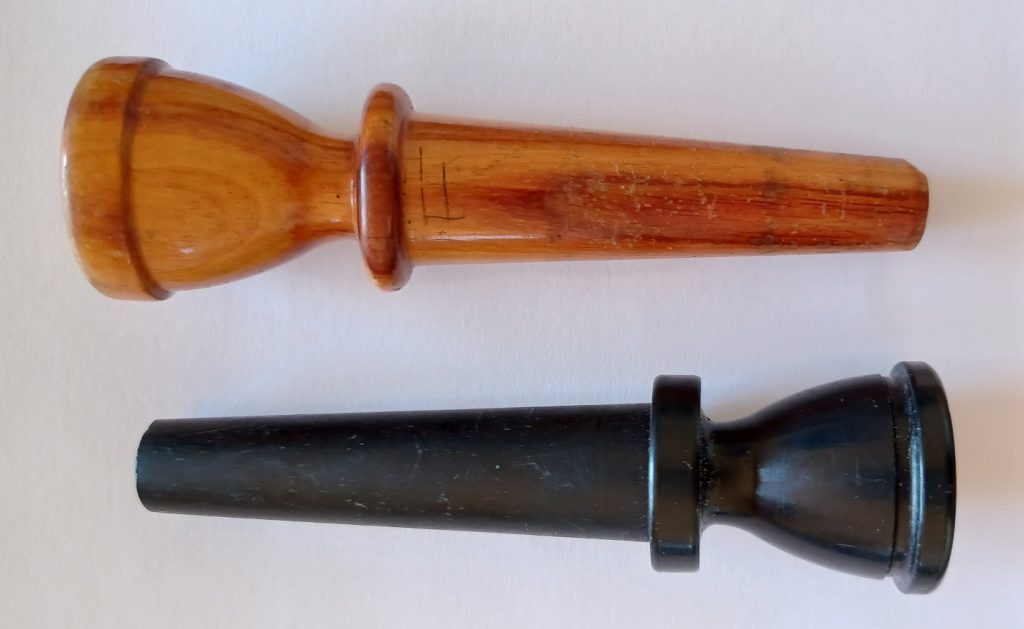
The inner life of the mouthpiece begins with the cup. After the narrowest point (“throat”), the mouthpiece diverges conically on the inside and thus guides the air almost seamlessly into the alphorn. Mouthpieces from different manufacturers differ in their cup shape. This can be more V- or U-shaped and is about 20-25mm deep. The diameter and length of the throat also affect the sound.

The width (“W” in the graphic above, sometimes also called “cup width” or “size”) is the most important parameter when chosing a mouthpiece. It refers to the inside diameter of the opening; hence you have to add the width of the rim for the external diameter. Normal mouthpieces are 17-20mm wide. Large mouthpieces respond better in the lower register, small mouthpieces reach the higher registers more easily. Unless you have a valid counter-argument, you should use a mouthpiece with a cup width of 18mm. The best thing to do is to start with it and stick with it for the first ten years! Two arguments: Firstly, there is no point in trying out different widths as a beginner – how do you want to judge which mouthpiece suits you if you have no experience? You have to get used to the unfamiliar thing and not the other way round adapt the mouthpiece to you. Secondly, it is counterproductive to change the mouthpiece when you have problems, because you have to readjust your fine motor skills every time. The mouthpiece is the least probable the cause of blowing problems. A change can only make sense in exceptional cases, and then under the guidance of an experienced alphorn teacher.
There is one valid counter-argument: if you already play another brass instrument. In this case, I would go for a width closer to that of your other mouthpiece – that’s why there are oversizes up to 24mm for tuba players. Alternatively, you can also use your usual mouthpiece with an adapter. The result sounds good with trombone and French horn. For the French horn there are also wooden mouthpieces with an embedded French horn metal mouthpiece. Trumpet mouthpieces, on the other hand, are less suitable for playing with an adapter due to their cup shape; in this case, a slightly smaller wooden mouthpiece is recommended on the alphorn.
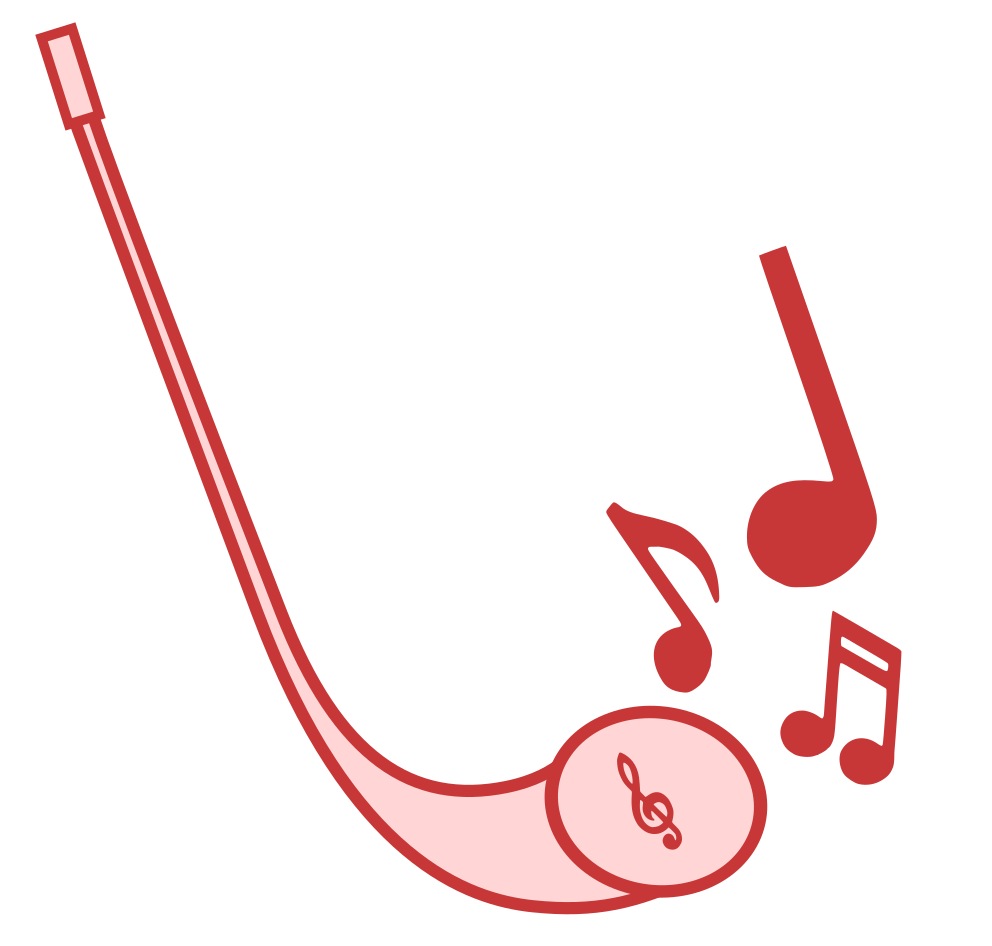 Breathe on
Breathe on
Objective: You manage to generate and hold a tone.
Contrary to common perception, you don’t need “strong lungs” to blow the alphorn. On the contrary: if you blow your alphorn with full force as a beginner, you will produce a horrible howl at best. Therefore, blow your first notes as gently as possible. Breathe air very gently through a small opening between your closed lips – imagine a bicycle tube with the air escaping through a small hole. When the air rubs against your lips like this, a subtle vibration is created. Let the tone of the alphorn develop. At first you only hear air flowing through the alphorn, your lips start to vibrate and the takes shape.
Limit yourself to these fine blows for the first few days. You may end up producing different pitches – that’s a good thing. You can also try blowing in the mouthpiece and then putting it on the alphorn while you are still blowing. In this video I show you the idea:
Also, try to hold the note for a few seconds. The audio files below can help you with this as an accompaniment: blow on a nice note, hold it and listen carefully as its sound merges with the (somewhat esoteric) synthesizer in the recording.
 A Short History of the Alphorn
A Short History of the Alphorn
Like the legend of William Tell, the history of the alphorn is surrounded by myths. There is often talk of a centuries-old tradition, of original Swissness, of an expression of a natural and original way of life. This image is cultivated to this day by the tourism industry and national-conservative forces. However, it is not confirmed by historic research.
It seems that mankind has been blowing horns on all continents of the world for a long time. The history of the Australian didgeridoo goes back several millennia. Silver “trombones” are mentioned in the Bible, among other places. Similar metal horns existed in ancient Egypt, India, China, Tibet and among the Celts (Carnyx). The ancient Romans also blew horns in what is now Swiss territory (Lituus and Bucina). Other materials were also used: terracotta (Etruscans), ivory (“olifants“), snails (Mexico) or animal horns. Horns made of wood or bark were already present in different regions of Europe in the Middle Ages – for example in Scandinavia (Lurs), Eastern Europe (Trembita) and different shepherd horns in the Alpine region. A demarcation between these shepherd horns and the – for a long time built in different shapes and lengths – alphorn, would be arbitrary. The alphorn is not a Swiss invention.
The term “alphorn” first appears in 1527 in the accounts of the monastery of St. Urban near Lucerne. The monastery had paid two silver coins to a transiting Walliser with his alphorn. In 1555, the Zurich botanist Conrad Gesner observed an alphorn player in his natural habitat on Mount Pilatus. Otherwise, there are few reliable sources about the prevalence and use of the alphorn in the mountains at that time.
Alphorn blowers appear on artistic depictions as musical accompaniment to alpine and cheese farming since the end of the 16th century. The alphorn plays for the alpine procession, calls the cows to the barn in the evening (the musical form of “Kühreihen” also testifies to this) and calms the animals during milking. To what extent this idyllic image was representative of the reality of the time cannot be reliably said. I doubt that the alpine dairymen in the 17th century regularly had the leisure to treat their cows to an alphorn tune while milking them after a hard day’s work.
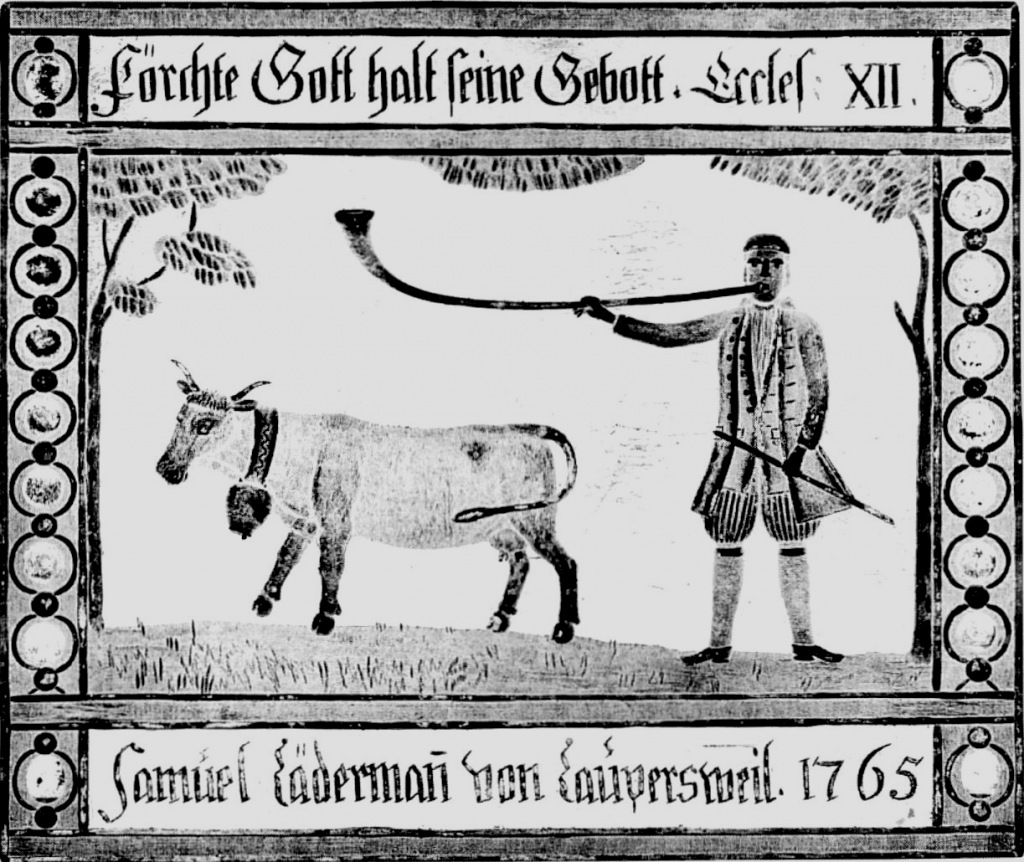
It is sometimes claimed that the alphorn was also used as a signaling instrument. However, there is no evidence for this. According to legend, farmers in the Entlebuch and the Valais used horns to summon the local militia as early as the 13th and 14th centuries. However, these were more likely animal horns – if these episodes happened at all. The touching story of the alpine dairyman who communicated via alphorn with his lover on the opposite alp is probably a myth of the 19th century.
However, it is documented that the alphorn was played for entertainment in town. Like the entry from 1527 at the monastery of St. Urban, most of the old written sources are about alphorn players who were on the road somewhere outside the mountain world: as vagrants or as exotic court musicians in the service of the nobility. The sound of the alphorn is said to have caused homesickness (le hemvé) among Swiss mercenaries in France and was therefore banned.
Numerous sources complain that towards the end of the 18th century the alphorn had largely disappeared from the mountains. Precisely this absence of the alphorn in the countryside was the origin of various urban efforts to “revive” it in the wake of Romanticism. This includes the Unspunnenfest of 1805. This display of folklorism has to be seen in its historic context. When Napoleon invaded Switzerland in 1798, he separated the Bernese Oberland from the town of Bern – much to the liking of the Oberland who had tried to break free from Bern for centuries. Five years later, After Napoleon’s departure, the city of Bern’s patricians were concerned with restoring their power over the rebellious Bernese Oberland – combined with promoting tourism. The motto “In honor of the alphorn” and blowing competitions gave the event a patriotic touch. But the Unspunnen Festival and other subsequent initiatives – such as those by Franz Niklaus König and the alphorn courses later organized by Ferdinand Fürchtegott Huber (the composer of “Luegid vo Bärg und Tal“) – failed to create a flourishing alphorn scene. At the end of the 19th century, this was still mainly limited to tourist folklore – be it as begging highwaymen or as an entertainment program organized by hotels (prominently described by Mark Twain in a chapter of his book “A Tramp Abroad”).
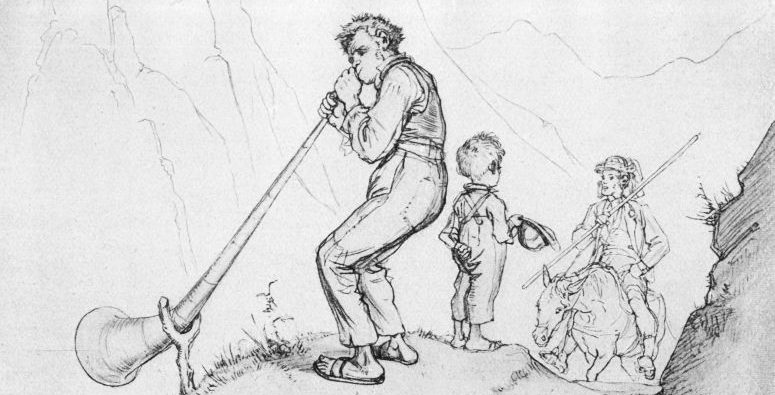
It was not until the 20th century that the alphorn rose to become the national instrument. The Federal Yodel Association, founded in 1910, played an important role in this. Alphorn courses and blowing competitions were institutionalized, and the construction of alphorns was standardized and professionalized. During this period the current form of the alphorn became established. Alfred Leonz Gassmann deserves special mention as a central figure. With his “Alphornbüechli” he published in 1938 a collection of sheet music that is still popular today, including a 10-point program for alphorn players. Gassmann also recognized the potential of intellectual national defense: the political environment around World War II generated a hunger for nationally unifying myths, traditions and symbols. At the latest with the national exhibition of 1939 (including patriotic “Landigeist”), alphorn blowing finally became popular.
Since the late 1960s, the history of the alphorn in Switzerland has played out in two parallel worlds. On the one hand, there is the world of the Swiss Yodelers’ Association. Here, rigid rules apply as to how traditional alphorn playing has to proceed. One plays in traditional costume and with fervent agogic. Reforms need a lot of time. Thus, polyphonic playing was not legalized until the 1970s – this date heralds the triumph of alphorn chorales and large formations. In the other world live the “savages” – all those who defy the rules, either because they do not share the official interpretation of the “original”, or because they want to open up new possibilities for the instrument. Thus the alphorn has found its way into pop, rock and jazz and does not shy away from interplay with classical music, modern serious music, electronic music or cultural exchange beyond national borders.
![]() Further information
Further information
- A research group a Lucerne University of Applied Sciences and Arts has recently done extensive research on the history of the alphorn and the link to yodelling; see here the english version of their book “Alpine Vibes” and the blog post by Yannick Way and Andrea Kammermann. In another article, Yannick Wey and Andrea Kammermann (2020). The Swiss Alphorn: Transformations of Form, Length and Modes of Playing, describe how the alphorn got its present shape.
- Regina F. Bendix (2018). Culture and Value: Tourism, Heritage and Property, uses the Unspunnenfest as a case study for the concept of invented tradition.
- Music-ethnologists describe the promotion of Swiss alphorn culture as a form of folk music revival. See the blog post by Lea Hagmann.
- Frances Jones has written several articles on the alphorn in the context of classical music. Here her summary of the history of the alphorn.
- Aindras Hirt (2015). The Devolution of the Shepherd Trumpet and Its Seminal Importance in Music History. Interesting article on shepard horns. The etymological origin of the word “trumpet” from the Pro-Indo-European language suggests that shepherd’s horns existed in Europe already several thousand years ago.
- If you liked the link to the artistic representations, you may also want to look at the archive of postcards with alphorn.
